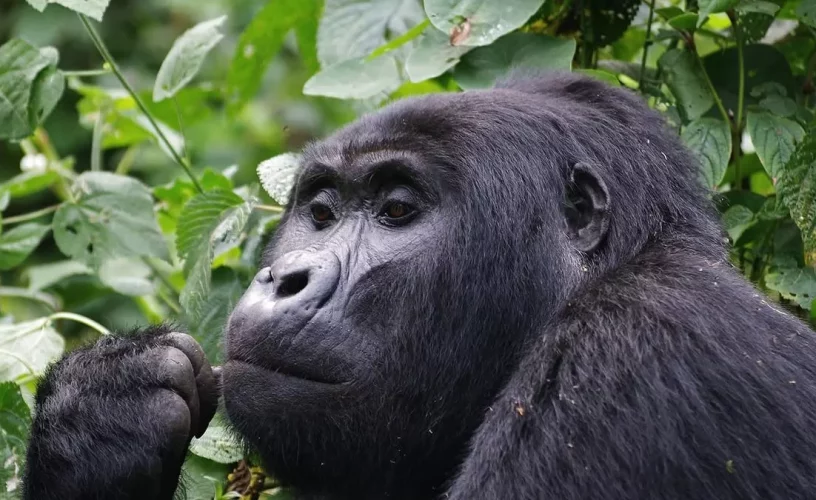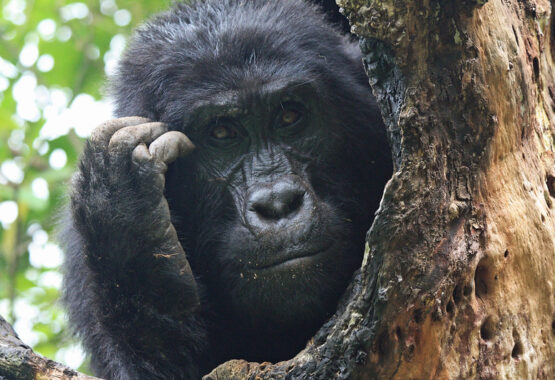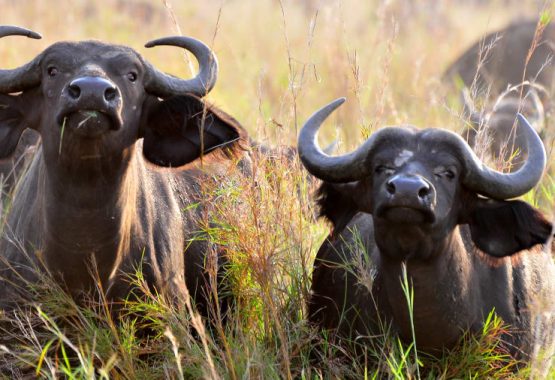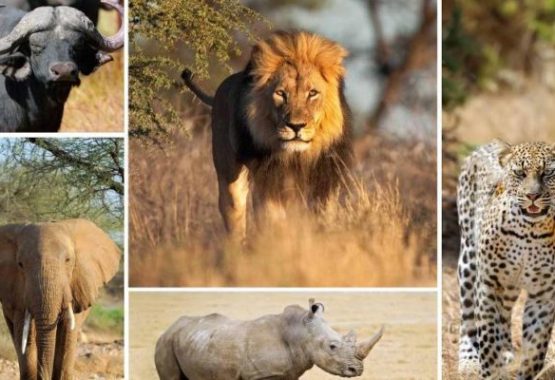What is a gorilla habituation experience?
A gorilla habituation experience is the rather laborious term that refers to the time a visitor spends with a team of specialists as they engage in the habituation process with a troop of gorillas. More specifically, a gorilla habituation experience is a four-hour session in which just four visitors a day are allowed to tag along with the specialists as they go about the various actions involved in getting a gorilla troop habituated.
One of the key differences between a gorilla trek and a gorilla habituation experience is that the latter takes place with a gorilla troop that is not yet fully accustomed to the presence of humans.
Gorilla habituation experiences have only been available since 2016. With only four visitors allowed per day, you can see that relatively few have ever enjoyed the honour of going on a habituation experience.
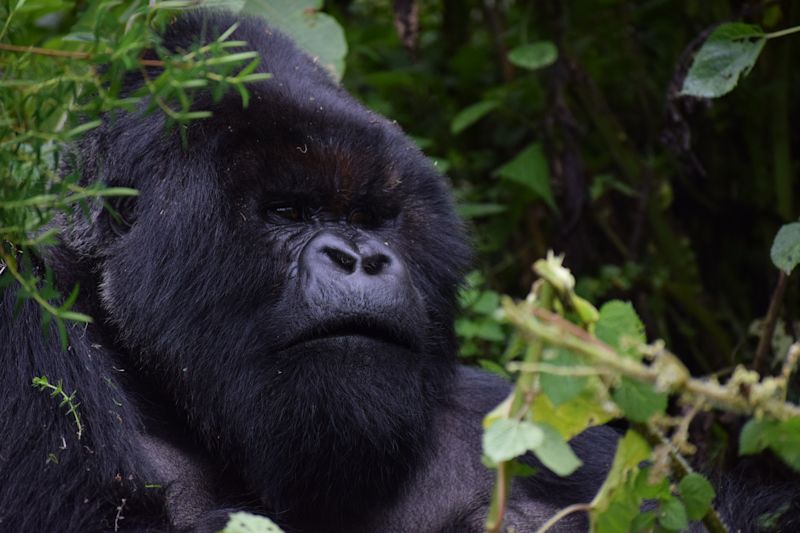
Close up of a silverback
What do you do during the experience?
A gorilla habituation experience begins with an early morning briefing. During the briefing the ranger will explain what to expect and some do’s and don’ts when in the presence of the troop.
You’ll then head out with the habituation team into the forest. (You head out much earlier than the gorilla trekking groups.) Led by a tracker or two, you’ll hike into the mountains in search of a troop. You’ll see how they look for the trail and the nests used by the troop during the night. This is part of the gorilla habituation process: seeing how the trackers work to find a troop. The gorilla treks later in the day are able to head straight towards a troop because the trackers have already pinpointed troops’ various locations.
When you find the troop, the rangers will do things like make gorilla calls and grunts. They’ll also chop vegetation with their machetes and talk among themselves. This is done to get the gorillas used to these noises.
The habituation team will also tell you about the troop being visited. This includes things like the names of each gorilla, and their habits and personalities.
Shyer gorillas
It’s important to note that if the troop you track is early on in the habituation process, the individuals are going to be quite shy around humans. This means you may not get as close to them as you would on a regular gorilla trek. Some may even stay hidden.
Note that a gorilla habituation experience sometimes doesn’t get you as close to the gorillas as a gorilla trek, as the troop is often shyer (having not yet become fully habituated).
So it’s important to understand that a gorilla habituation experience often introduces visitors to a troop that’s shy or nervous around humans. In one sense you’re getting a more authentic experience with the gorillas. But some could be disappointed if they’re expecting a really close-up encounter.
Of course, all that said, if your troop is far along in the habituation process, then you may well have a very intimate session with them. We advise managing your expectations, and then if you do get a really friendly troop, lucky you!
The four hours include tracking time
Please also note that some of the four hours of the habituation experience involve tracking the gorillas. Specifically, the time spent tracking the gorillas from their night-time nests is considered part of the experience. So you won’t necessarily spend four hours in their presence.
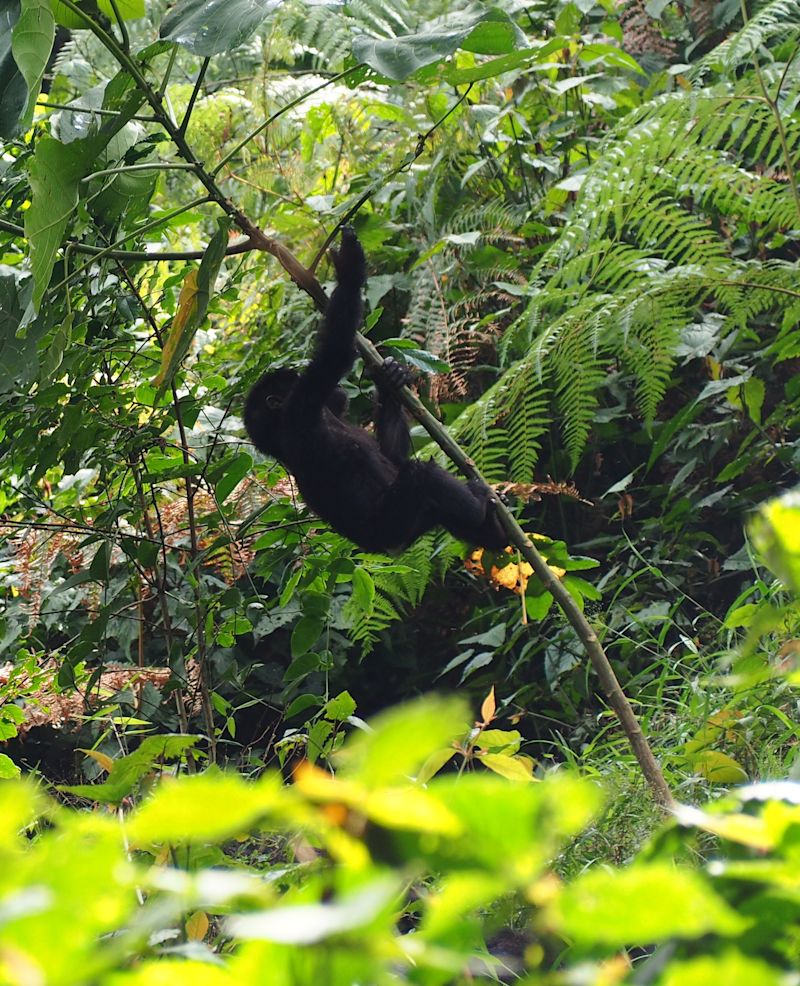
Watching the infants at play is one of the best parts of spending time with a troop
How fit do I need to be?
A gorilla habituation experience usually involves a pretty taxing hike of a few hours, so you need reasonable fitness to cope. It is often also muddy and slippery, so you want to be reasonably sure-footed.
Many trekkers hire porters to carry their backpacks, and we encourage this. Not only does it provide much-needed work, you really feel the advantage. These guys and gals spring along with your backpacks, while most visitors find the trek plenty tough enough even without a pack on their backs.
Is there an age limit?
Children under the age of 15 aren’t allowed to go on a gorilla habituation experience.
Where are habituation experiences offered?
The only place offering gorilla habituation experiences is Bwindi Impenetrable National Park in southwest Uganda. More specifically, the only part of the park offering a gorilla habituation experience is the Rushaga sector in the south (see the map below).
Accommodation
Bwindi is a very large park, and you’ll need to find accommodation inside or near to Rushaga sector to be able to make the early morning meeting time for the habituation experience. There are luxury, mid-range and budget accommodation options available in this area.
Note that you must present your passport when you arrive for your habituation experience. If you have a tour guide with you on your trip, he or she will ensure you’re aware of and don’t forget important details such as this.
How do I get to Bwindi?
To get to Bwindi, either fly into Entebbe International Airport in Uganda or Kigali International Airport in Rwanda and then drive there. We recommend going with a reliable tour operator who does the driving and navigating for you.
How much does it cost?
A gorilla habituation permit costs US$1,500 per person.
If you want to hire a porter to carry your backpack (and the work is appreciated by them), then factor in another $20. This doesn’t include a tip. And tipping is customary in Uganda. Not only should you factor in a tip for your porter, but please also consider tipping your rangers and trackers. Tips are best when given in Ugandan shillings.
Must I book in advance?
Yes. In non-pandemic years (!), gorilla habituation permits sell out months in advance. Remember that only four habituation permits are issued per day, far less than gorilla trekking permits. And gorilla habituation experiences only take place in Bwindi Impenetrable National Park.
Bwindi Park recommends you book at least six months in advance, especially if you want to go during the dry seasons. The dry seasons (or ‘drier’ seasons to be more accurate) are December to March, and June to October. But gorilla habituation experience permits are issued all year round, so you needn’t limit yourself to these months.
If you’re interested in pairing your gorilla habituation experience with other sightseeing in Uganda, we recommend reading Best time to visit Uganda.
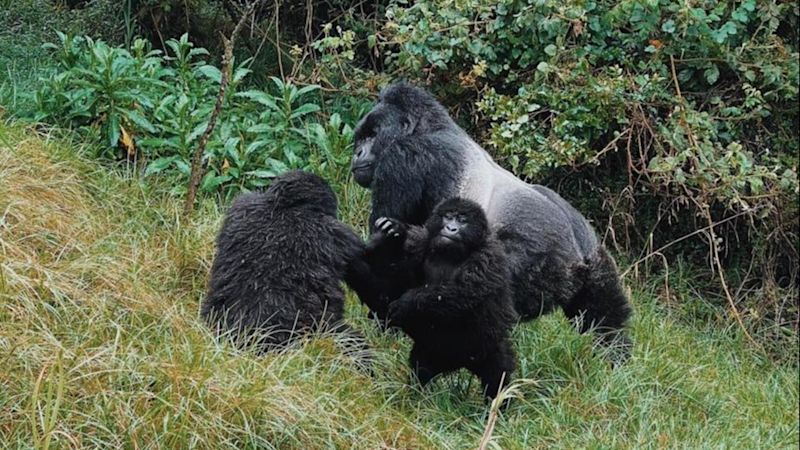
A silverback and two young gorillas
Is it safe?
Yes, a gorilla habituation experience is safe. This is because you’re in the presence of professionals who know what can and can’t be done around the troop visited. Of course you must obey all instructions and follow all directions to actually stay safe. No rogue photo op missions or the like.
Gorillas let you know if they’re unhappy; for example, the silverback might pound his chest. The rangers are well trained in understanding and responding responsibly to these signals.
Is it ethical?
All things counted, yes, gorilla habituation and gorilla habituation experiences are ethical practices. We say this because the Uganda Wildlife Authority ensures that both are done in a well-considered manner, with the best interests of the gorillas in mind.
Further to this, gorilla habituation experiences are offered at a high price and the money generated is used in large part to further the park’s mountain gorilla conservation efforts.
In an ideal world, mountain gorillas would be left alone in the wild. However, the apes require a concerted effort on the part of humans to protect their numbers from poachers and habitat loss. With this need in mind, the thoughtful implementation of gorilla treks and gorilla habituation experiences is overall a good thing.
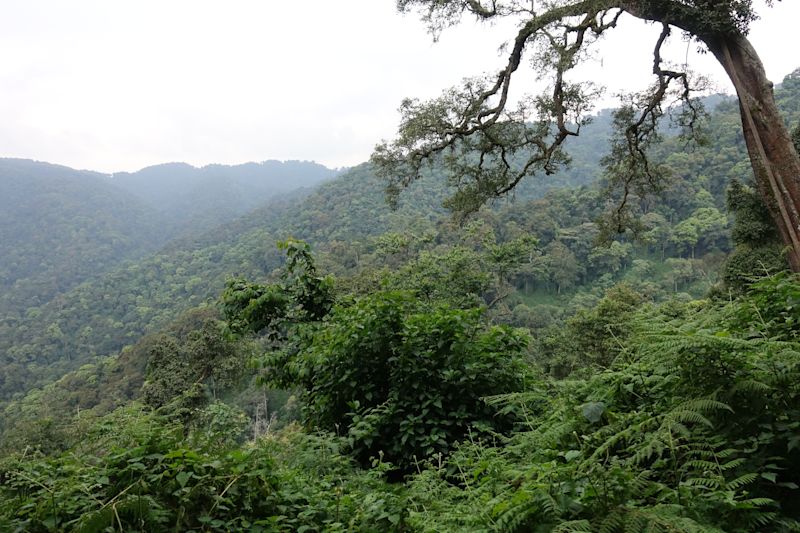
Bwindi Park is financed in large part through gorilla trekking and habituation permits
What should I wear?
We recommend covering up entirely except for your face for your habituation trek. Avoid brightly coloured clothes, and opt instead for browns, greys, dark greens and khakis.
The most critical items to bring on a gorilla habituation trek are:
- A backpack (and a waterproof backpack cover is a good idea too)
- Plenty of water and a packed lunch
- Worn-in, sturdy and water-resistant hiking boots
- A warm or thermal jumper or jacket as it can be very cold at such high altitude in the early morning
- A long-sleeved top (bare arms invite insect bites and scratches)
- A rain jacket (it can rain even in the so-called dry seasons)
- Long pants to protect your legs from being scratched
- Hiking socks to further protect your calves (and choose ones made with sweat-wicking material)
- Thick gloves like gardening gloves to protect your hands when you grip or move aside vines, which can be thorny
- A sunhat and sunscreen, as the sun can be pretty fierce when the clouds clear
We also recommend wearing gaiters to help keep your feet and ankles dry. They also help to keep mud and stones out of your boots. And provide a little extra warmth in the cold early hours.
Finally, we really recommend bringing along trekking poles (or a walking stick) to help you on the hike. As mentioned, it’s often muddy in the forest and trekking poles help you to tackle slippery sections and cross streams. You can learn more in our post Ultimate guide of what to pack for gorilla trekking.

